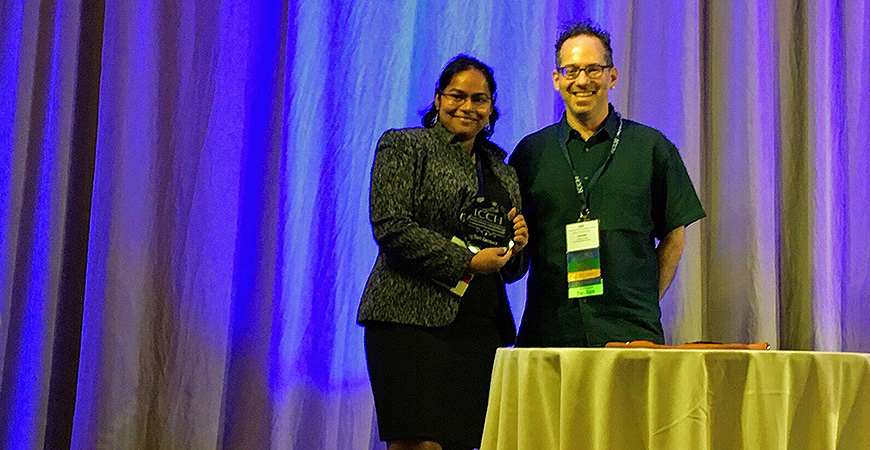
Dr. Deepti Chittamuru won the best abstract award (of 700 abstracts submitted) at the 17th International Conference on Communication in Healthcare (ICCH 2019) organized by the Academy of Communication in Healthcare. She was also awarded the Health Equity Scholarship by the Academy of Communication in Healthcare. The Academy of Communication in Healthcare (ACH) is deeply committed to innovative research in and teaching of relationship-centered communication in the context of the healthcare system.
At ICCH 2019, Dr. Chittamuru presented an abstract discussing a quasi-randomized controlled trial to evaluate the effect of values-based message frames on multiple Facebook audiences in the context of a public health literacy campaign to prevent Type-2 Diabetes. She found that contrary to prior research there were patterns in the efficacy of values-based message frames across multiple Facebook audiences. Some values based message frames were consistently more appealing to disparate Facebook audiences while others consistently underperformed across these audiences.
Dr. Chittamuru is currently a postdoctoral fellow on UC Merced’s Communication, Culture, and Health research team research team, led by Associate Professor of Public Health Communication Susana Ramirez. Dr. Chittamuru earned a Ph.D. in communication from the Annenberg School for Communication at the University of Pennsylvania, an M.S. in Information Management and Systems focusing on Human-Computer Interaction from the University of California at Berkeley, and a B.S. in Computer Science and Systems Engineering from Andhra University. She has extensive experience in designing, deploying and evaluating technology-based interventions in a wide variety of contexts such as public health, public education and agriculture.
Abstract
Title: Public Health Literacy Among Facebook Audiences: A Quasi-RCT Evaluating Message Frames for Type 2 Diabetes Prevention
Authors: Deepti Chittamuru, Ryane Daniels, Urmimala Sarkar, Dean Schillinger
Background: Over the last two decades, the prevalence of type 2 diabetes (T2D) has rapidly escalated in the US, and is now affecting youth and young adults in epidemic proportions. In order to reverse this trajectory, it is widely recognized that both policy-makers and the general public need to problematize T2D less as a medical and more as a social problem. Finding avenues to successfully convey a socioecological perspective on the root causes of T2D to broad segments of the population who are not part of the public health subculture represents a challenging imperative for changing the social and environmental policies that drive the epidemic. Prior research has suggested that this shift in disease construct may be particularly unacceptable for more individually- and behaviorally-minded segments of the population.
Methods: An award-winning T2D prevention public health literacy campaign (www.thebiggerpictureproject.org) was harnessed to determine the most successful ways of framing ads on a social media platform. Six parallel RCTs (Participants N=203156) were conducted across 6 unique audience segments defined through the Facebook (FB) ads manager tool. They employed user data to generate targeted samples (N~5,000 per audience): Youth, Social Justice Interest, Nutrition/Food Interest, Public Health Interest, Philanthropists/Donors, and Individualists. Nine unique ad frames-10-15 word appeals- employing values-based communication theory were used, including: Entertainment Appeal; Common Enemy/Military Appeal; Play on Genetics; Play on Personal Responsibility; Defiance Against Authority; Protecting Friends & Family; Economic/Tax Burden Appeal; Second-Hand Smoke/Environmental Appeal; and Facts & Figures. Our outcome was audience engagement, defined as the proportion who made a unique link click to view the video in response to the ad’s framing message. We hypothesized that there would be significant variation in the effectiveness of ad frames across audiences. We compared rates of engagement in aggregate (a) across audiences and (b) by ad frame within audience segments.
Results: Rates of overall engagement varied across audience segment, with the highest rates/similar aggregate rates observed within Social Justice [LSMean=78.7,S.E.=4.6,p<.0001], Nutrition [LSMean=77.2,S.E.=4.7,p<.0001] and Individualist [LSMean=70.7,S.E.=4.7,p<.0001] and the lowest rates among Youth [LSMean=21.7,S.E.=4.7,p<.0001] and Public Health [LSMean= 53.2,S.E.=4.7,p<.0001] audiences. Contrary to our hypothesis, we observed remarkable consistency across audiences with respect to those ad frames that were most or least associated with engagement. The ad frames that consistently ranked highly in the audiences included Entertainment Appeal [LSMean=81.3,S.E.=6.4,p<.0001]; Defiance Against Authority Appeal [LSMean= 69.2,S.E.=6.3,p<.0001]; and Second Hand Smoke/Environmental Appeal [LSMean= 84.5,S.E.=6.9,p<.0001]. Ad frames that consistently ranked in the bottom included Facts & Figures [LSMean= 41.3,S.E.=7.2,p<.0001], Social/Racial Injustice [LSMean=50.9,S.E.=6.9,p<.0001] and Healthcare Costs [LSMean= 55.4,S.E.=7.8,p<.0001].
Conclusions: Our parallel trials suggest that a broad range of social media users appear to respond positively to messages framed as offering content that is entertaining, calling out threats to personal autonomy, and appealing to the injustice of exposing youth to unhealthy environments. Our study suggests that, across disparate segments of US society, there may be a set of common values that communication initiatives can tap into so as to create common ground and catalyze a broader and more inclusive movement to confront the T2D epidemic through policy, systems and environmental approaches.




